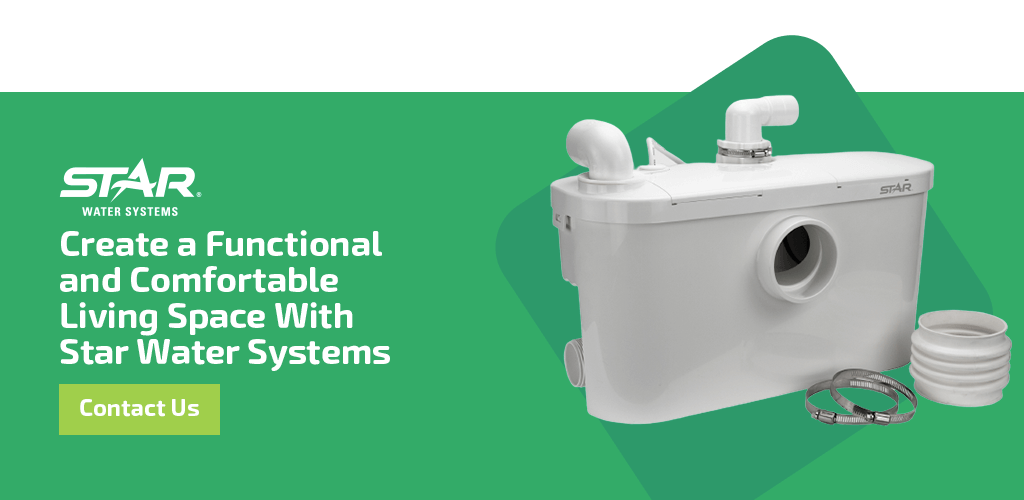How to Convert Your Garage or Basement Into an Additional Living Space
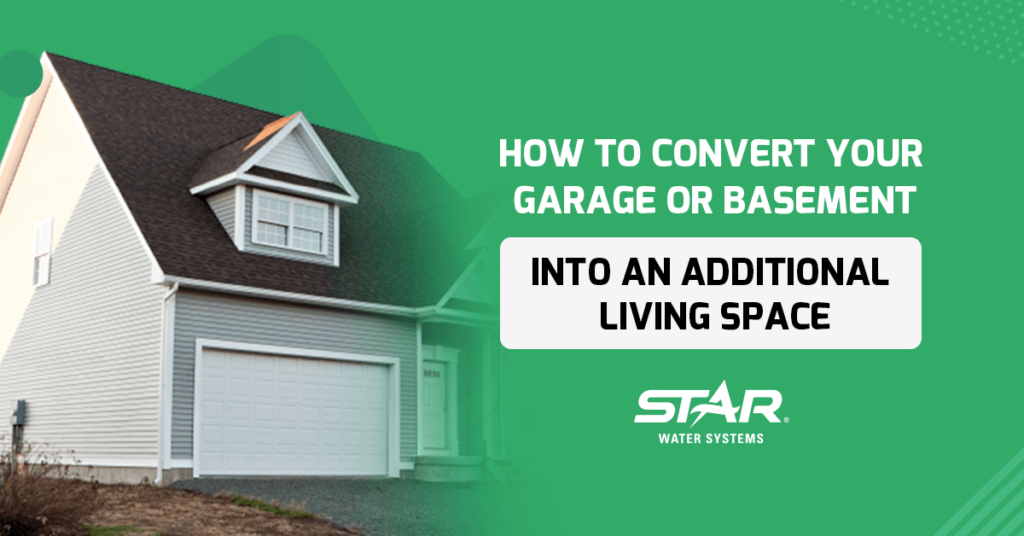
Learning more about how to convert your garage or basement into an additional living space can help you create the most functional and comfortable space possible. While basements and garages are designed primarily for storage and car shelter, these spaces can make excellent living spaces. Converting your unused basement or garage presents new opportunities and allows you to welcome more guests, friends and family members into your home for extended stays.
You can successfully convert your basement or garage into a living space by ensuring the space is dry, installing a bathroom, adding a kitchenette, installing a washer and dryer and upgrading the walls and flooring.
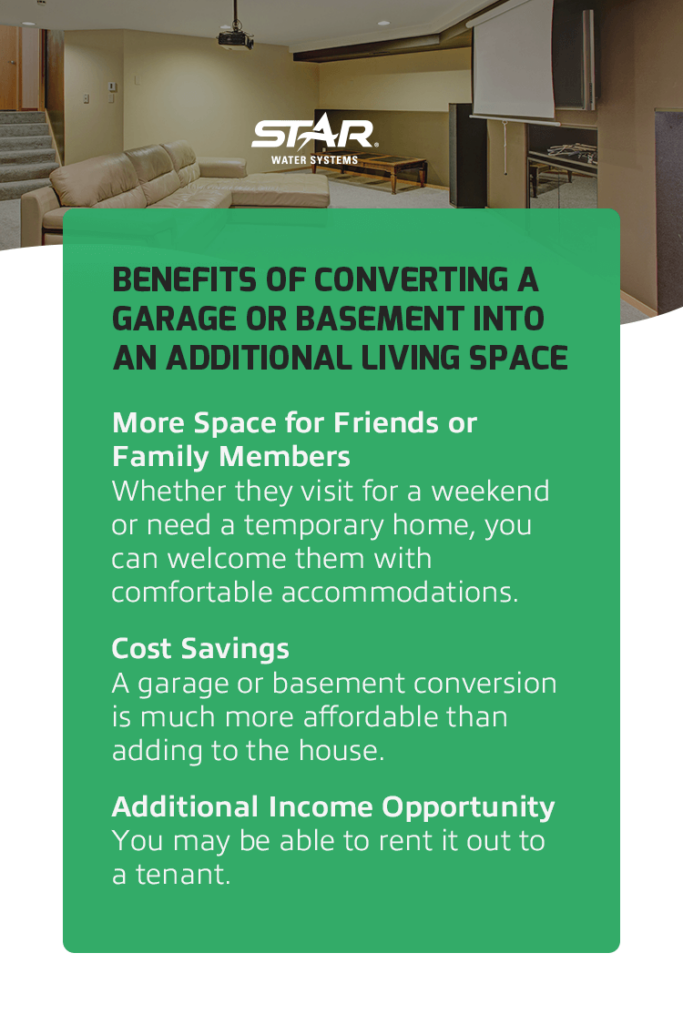
Benefits of Converting a Garage or Basement Into an Additional Living Space
While homeowners often use garages and basements for storage space, converting your basement or garage into an additional living space provides the following benefits:
More Space for Friends or Family Members
You can create more space for friends and family when you add an additional living space to your home. Whether they visit for a weekend or need a temporary place to call home, you can welcome them with comfortable accommodations. An additional living space makes it easy to entertain guests and invite them to stay longer if they visit from out of town.
Additional living space is also convenient if you have adult children who need a temporary place to live while they save for a home of their own. As housing prices continue increasing, more young adults and college graduates are choosing to live with parents or family members until they grow their savings. Transforming your garage or basement is an excellent way to provide a comfortable living space while maintaining privacy for yourself and your adult child.
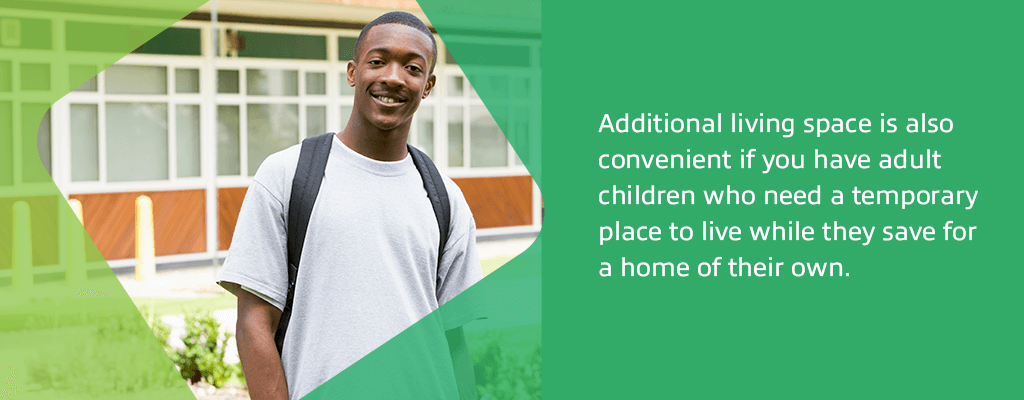
Cost Savings
Converting your garage or basement into a living space can also help you save money. A garage or basement conversion is much more affordable than adding to the house. Adding an extension to your home typically requires excavation, foundation work and new wiring, which can quickly increase your costs. Converting a preexisting space is faster and easier because it requires updating instead of building an entirely new structure.
Additional Income Opportunity
Depending on how functional you make your additional living space, you may be able to rent it out to a tenant. Renting the space allows you to collect an additional income stream you can use to pay off your mortgage or put toward other bills.
How to Convert Your Garage or Basement Into an Additional Living Space
Converting your garage or basement into an additional living space requires some installments and upgrades. A living space requires a comfortable atmosphere, functional appliances and insulation. Consider the following tips to transform your garage or basement successfully:
Obtain the Proper Permits if Necessary
You may need a permit to convert your garage or basement depending on your city and the changes you plan to make. Learn more about your city’s zoning laws and learn how to apply for a building permit in your state. You will need to ensure you meet local building codes and ordinances, and you may need to schedule an inspection after your conversion is complete.
Install an Upflush Toilet
A full bathroom is an excellent feature for an additional living space. It provides convenience and privacy because it allows guests or tenants to use the bathroom and shower without utilizing other parts of the house.
While some bathroom installations require you to break concrete and dig to access plumbing lines, there is an easier option. You can add a bathroom to your garage or basement quickly and easily with an above-floor plumbing system that doesn’t require existing plumbing.
An upflush toilet is an above-floor plumbing system that uses a macerator or grinder pump to break down solid waste and send it to the main sewer line. You can install this type of plumbing system on top of the floor behind a toilet to pump wastewater upward or horizontally, and it can pump wastewater from a bathroom’s toilet, tub, sink and shower. You can install a fully functioning bathroom in your basement or garage with one of the following options:
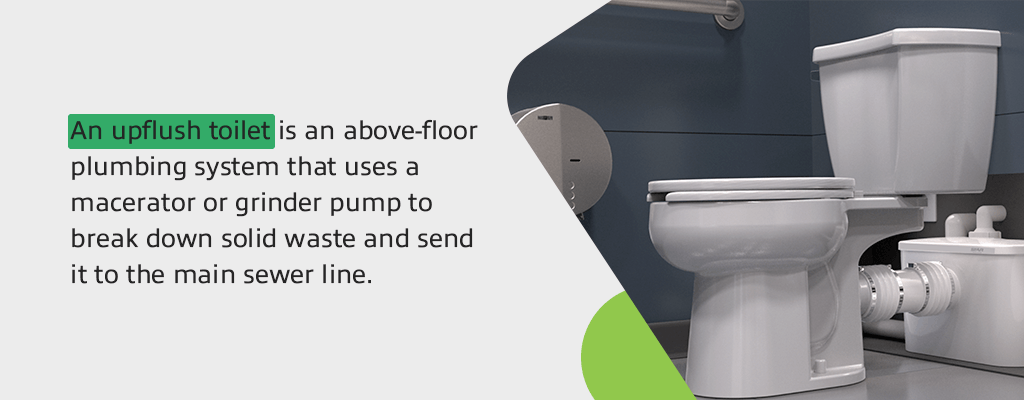
1. Powerflush Optima
The Powerflush Optima is an instant toilet system with a ⅓ HP macerator pump. The macerator pump grinds solid organic waste and toilet paper effectively so it can transfer to the main sewer system. You can install this solution instantly without breaking concrete or altering your home’s existing plumbing. The Powerflush Optima is easy to install, helping homeowners save time and money on construction and remodeling projects.
You can mount the Powerflush Optima directly to the floor, and it can pump wastewater vertically up to 20 feet to reach the main sewer lines. This vertical reach enables you to install a bathroom anywhere in your home. You can install the Powerflush Optima as a freestanding unit or use an extension kit to conceal it behind a wall.
Connect this convenient system to your toilet, bathtub, shower or sink to transfer wastewater efficiently. Its modern design provides excellent performance and a sleek appearance.
2. Powerflush Optima Pro
Like the Powerflush Optima, the Powerflush Optima Pro pumps wastewater and solid waste to the main sewer system efficiently. However, the Powerflush Optima Pro provides greater power with a ½ HP grinder pump. While the Powerflush Optima’s macerator pump can grind small solids, the Powerflush Optima Pro’s grinder pump can handle medium and large solids.
You can also install the Powerflush Optima Pro without altering your home’s plumbing system or breaking through concrete. Like the Powerflush Optima, this upgraded instant toilet can grind solid waste and pump it and wastewater up to 20 feet vertically. Its easy installation allows you to mount it directly to the floor as a freestanding unit or conceal it behind a wall.
Consider adding other water fixtures to your bathroom by plumbing a bathtub, shower and sink into the Powerflush Optima Pro for a full, beautiful bathroom.
Add a Laundry Room
A laundry room is another excellent addition to a living space, especially if you rent the space to a friend or family member. A washer and dryer add convenience to a living space by eliminating the need to visit a laundromat, making your guest’s or tenant’s life much easier.
You can install a laundry pump to easily add a laundry room to your home without breaking concrete. Star Water Systems offers the STL001 Laundry Pump to pump water from spaces that lack a gravity drain line. With the STL001 laundry pump, you can install a washing machine without traps or vents. Its switch design enables manual and automatic operations, and it comes with the following features:
- Sink drain screen
- 1 ¼-inch national pipe taper (NPT)
- 1 ¼-inch NPT ball valve
- 1 ¼-inch slip check valve
- 60Hz, 115v thermally protected motor
Add a Small Kitchenette
A small kitchenette adds extra convenience to your additional living space. With a small kitchenette, your friends, family members or tenants can store and prepare food and wash dishes. A Drainmaker Wet Bar System enables you to install a sink nearly anywhere in your home. This sink pump is easy to install, allowing you to add a sink to your garage or basement without breaking through concrete or altering your existing plumbing.
The Star Water Systems Drainmaker Wet Bar System contains a 1 ½-inch discharge and a nonclogging vortex impeller. It operates automatically and can pass up to 3/8-inch solids.
Waterproof the Space
Ensure your basement is clean and dry before updating walls or flooring, and waterproof the space if necessary. Using a plastic sheet and duct tape, you can check if your basement is dry.
Use duct tape to secure a large plastic sheet to your basement’s concrete wall and wait 24 hours. Examine the sheet after 24 hours to check if condensation is present. If you find condensation, addressing the moisture before working on the walls and flooring is important.
Moisture can affect your basement during a flood, heavy rain or snow melt. Waterproofing the space protects it from potential water damage, mold and mildew. While addressing existing moisture is crucial, you should also consider waterproofing your basement if it is dry. A dry basement can collect water easily if your area receives heavy rain, so it’s important to be prepared.
Address moisture in your basement by installing a quality sump pump, sealing the walls with masonry sealant and adding gutters and downspouts to your house. Sump pumps automatically detect when water enters a basement’s sump basin and pump the water outside before it accumulates.
You can prevent water damage with a submersible or pedestal sump pump. Submersible pumps are the most efficient type of sump pump, and they operate quietly underwater. Pedestal pumps partially submerge in water and serve as excellent replacement pumps.
You should also consider the type of material a pump is made of. Cast iron is the most durable sump pump material, and it dissipates heat the most effectively. Thermoplastic and aluminum pumps are the most cost-effective option, and they are common in residential applications.
A pump’s float is another important factor. The float is the component that activates the pump to start operating when water accumulates. Some pumps have a vertical float while others have a tethered float. Both float types rise with water and activate the pump to operate once the water reaches a certain level, but tethered floats require more space to function properly.
While a certain type of pump may be sufficient for your application, a pump with a vertical float and high horsepower (HP) is effective in any application.
Update the Walls
Walls are also important when updating a garage or basement. They affect the living space’s appearance, comfort level and insulation. If you want to run electricity through your walls, checking your local building codes and contacting an electrician before working on the walls is important. Building codes indicate how many outlets you can add to the space.
1. Updating Basement Walls
You can paint brick, cinderblock or poured concrete walls a solid color to brighten the space. You can also install drywall, but it must be mildew- and moisture-resistant for the best results. If you insulate your basement walls, you can apply faced rigid foam board directly to the concrete walls.
2. Updating Garage Walls
Insulating your garage walls improves energy efficiency and can help you save money on heating and cooling your additional living space. After insulating your garage walls, you can hang drywall or a drywall alternative, such as wallboard panels or fiberglass reinforced panels (FRP).
Drywall is the best option because it increases energy efficiency and is cost-effective. It’s also beneficial because you can hang items on drywall for decoration or storage.
Update the Flooring
Floors also affect a space’s appearance, insulation and comfort. Consider the following options for updating your garage or basement flooring when you convert it to a living space:
1. Updating Basement Floors
You can finish your basement floor or apply a sealer to prevent fine dust from accumulating. You can also paint the floor to improve its appearance and place area rugs in the space to create a cozy atmosphere and increase warmth.
2. Updating Garage Floors
You can update your garage floors with carpeting or tile to create a comfortable living space. If you add carpeting, use indoor/outdoor carpeting to resist moisture and prevent mold. Replacing the garage door with a wall is important if you plan to carpet your garage space. Carpeting is an excellent addition to a living space because it increases warmth and makes the space feel cozier.
If you choose tile floors, you can install tiles made from polymers such as polypropylene or PVC, or you can lay ceramic tile. Interlocking tiles are easy to install and require no adhesive. Ceramic tile requires slightly more effort to install but withstands foot traffic and spills very well.
Tile flooring is excellent for a bathroom, laundry room or kitchenette space. Whether you place tile flooring on the entire garage floor or use it for part of the space, it’s a great addition.
Create a Functional and Comfortable Living Space With Star Water Systems
Converting your garage or basement into a living space allows you to welcome friends and family members for extended stays, provide a temporary home for your adult children or rent a room to a tenant. Making the proper changes with the right materials and appliances ensures your new living space is functional and comfortable.
Once you research and obtain the required building permits, you can add features such as a functional bathroom, kitchenette, laundry room, updated flooring and new walls. These changes can significantly enhance your space, increase insulation, improve comfort and transform your unused space into a fantastic living area.
Star Water Systems offers high-quality upflush toilet systems, laundry pumps and wet bar systems to help homeowners add functional bathrooms, laundry rooms and kitchenettes to their homes without breaking concrete. These systems and pumps allow you to install toilets, showers, sinks and washing machines in any space in your home quickly and easily.
We also offer powerful sump pumps to help you keep your converted basement space dry and safe from water damage. Locate the nearest retailer to find quality Star Water Systems and transform your space effectively.
 Buy Now at Lowes
Buy Now at Lowes